We use cookies
Using our site means you agree to the use of cookies and similar technologies. Read about our policy and how to disable them here
Winston Churchill-August 20, 1940
This story doesn’t really have much to do with fencing, but I want to share it with you anyway. It was in 2006, I’d flown to London for work. I was staying with Barry Paul and his wife Joan, who live near the Brent Reservoir in Wembley. Barry is Leon Paul’s grandson and now owns the Leon Paul Fencing Equipment Company. In his day, Barry was a 5 time National Foil Champion of England and he knows the sport of fencing like no one else I have ever met. He is a naturally funny man with great sense of humor and a heart of gold. Barry was making breakfast for us and he asked me to walk to the store on the corner to get some eggs. Anxious to comply with my boss’s request, I started walking down the street. After a few minutes I started wondering where this egg store was and began wondering if I had walked the wrong way. As I started to turn around something in the bushes caught my eye—it was an old tombstone. I found an opening to get behind the bushes and within a few steps I had left a nice London neighborhood and entered the overgrown graveyard of a very, very old stone church. It looked like no one had visited this graveyard in years. I was astonished. I felt as if I had gone back in time.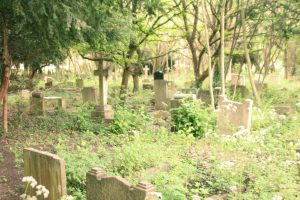 For about a half hour, I just walked around looking at the old graves and then, right in front of me, was a marker inscribed with the words, A LOVING TRIBUTE TO THE MEMORY OF SQUADRON LEADER P. CAMPBELL PINKHAM A.F.C. “TOMMY” KILLED IN AIR COMBAT 5TH SEPTEMBER 1940 AGED 25 YEARS
For about a half hour, I just walked around looking at the old graves and then, right in front of me, was a marker inscribed with the words, A LOVING TRIBUTE TO THE MEMORY OF SQUADRON LEADER P. CAMPBELL PINKHAM A.F.C. “TOMMY” KILLED IN AIR COMBAT 5TH SEPTEMBER 1940 AGED 25 YEARS
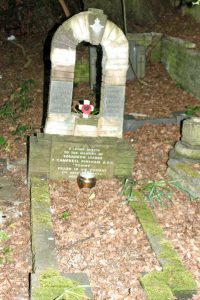
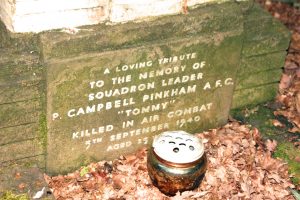 Clearly Tommy Pinkham was a casualty of World War II, but what had happened? What kind of plane did he fly? Had he been killed by the enemy in one of the legendary air dogfights ? What thoughts must’ve been going through his mind during the last 5 minutes of his life? And why had his grave been forgotten? Could anything be done to honor the memory of this brave young man? It was a surreal moment and I didn’t really understand why this was impacting me so much.
Remembering my original mission, I quickly went to the other end of the street, got the eggs and walked back in the door to find my cold cup of coffee sitting next to a rather perturbed Barry Paul. An hour had passed since I had left to get the eggs. Being the wonderful man that he is, Barry quickly forgot about being irritated with me. But, I couldn’t stop thinking about Squadron Leader Tommy Pinkham, who had given his life defending England and was now alone and forgotten in an old, overgrown London cemetery. That evening, I went back to the cemetery for another look at his grave.
Tommy was on my mind much of the trip back to America. I had found a link to the past. It was a link to a war I had heard so much about and a link to British aviation history. I wanted to know more about him.
A quick search of the internet lead me to an aviation forum where some details were given in the combat report from September 5th, 1940. Some books containing information on Tommy were mentioned. On subsequent trips to London I visited Tommy’s grave several more times. I checked the internet again and again. Each time, more information about Tommy would appear. I ordered books that I knew contained information on him. The Royal Air Force and British Ministry of Defense were able to provide me with official documents. It was almost like this World War II fighter pilot had befriended me and wanted me to learn more about him.
Born on May 29th, 1915, Tommy grew up with his family in Kingsbury, a London neighborhood near Wembley. He lived on Rossdale Drive with his parents, Philip and Nora, his two sisters and twin brothers. Their home was about a half mile from the Brent Reservoir and the church where he is buried. He had attended Kilburn Grammar school from 1926 to 1932. In 1933 he joined the Royal Air Force as a pilot officer.
Clearly Tommy Pinkham was a casualty of World War II, but what had happened? What kind of plane did he fly? Had he been killed by the enemy in one of the legendary air dogfights ? What thoughts must’ve been going through his mind during the last 5 minutes of his life? And why had his grave been forgotten? Could anything be done to honor the memory of this brave young man? It was a surreal moment and I didn’t really understand why this was impacting me so much.
Remembering my original mission, I quickly went to the other end of the street, got the eggs and walked back in the door to find my cold cup of coffee sitting next to a rather perturbed Barry Paul. An hour had passed since I had left to get the eggs. Being the wonderful man that he is, Barry quickly forgot about being irritated with me. But, I couldn’t stop thinking about Squadron Leader Tommy Pinkham, who had given his life defending England and was now alone and forgotten in an old, overgrown London cemetery. That evening, I went back to the cemetery for another look at his grave.
Tommy was on my mind much of the trip back to America. I had found a link to the past. It was a link to a war I had heard so much about and a link to British aviation history. I wanted to know more about him.
A quick search of the internet lead me to an aviation forum where some details were given in the combat report from September 5th, 1940. Some books containing information on Tommy were mentioned. On subsequent trips to London I visited Tommy’s grave several more times. I checked the internet again and again. Each time, more information about Tommy would appear. I ordered books that I knew contained information on him. The Royal Air Force and British Ministry of Defense were able to provide me with official documents. It was almost like this World War II fighter pilot had befriended me and wanted me to learn more about him.
Born on May 29th, 1915, Tommy grew up with his family in Kingsbury, a London neighborhood near Wembley. He lived on Rossdale Drive with his parents, Philip and Nora, his two sisters and twin brothers. Their home was about a half mile from the Brent Reservoir and the church where he is buried. He had attended Kilburn Grammar school from 1926 to 1932. In 1933 he joined the Royal Air Force as a pilot officer.
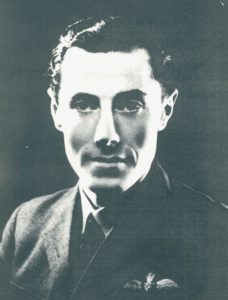 Tommy Pinkham was the Squadron Leader of the Royal Air Force No. 19 Fighter Squadron and had the distinction of being the youngest squadron leader in the RAF. He assumed command on June 3rd of 1940 after the previous squadron leader, G. D. Stevenson, had been shot down and taken prisoner of war. He had a remarkable amount of experience for a 25 year old flight lieutenant. During his career, Tommy had flown a number of different planes, many of them being single engine bi-planes. He flew the Avro Tutor, the Hawker Hart, the Hawker Audax, the Hawker Fury, the Bristol Bulldog, the Gloster Gauntlet, the Gloster Gladiator, the Westland Wallace, the Miles Magister and the plane that he was killed in, the Vickers-Supermarine Spitfire Mk 1.
Powered by a Rolls Royce Merlin II engine, the Spitfire Mk 1 was originally equipped with eight 7.7mm Browning machine guns. The comparable Luftwaffe aircraft, the Messerschmitt bf109 was equipped with two 7.9mm machine guns and two 20mm canons, which were capable of greater destruction than the smaller machine gun bullets. No. 19 Squadron was selected to test a new version of the Spitfire, which was equipped with no machine guns and two 20mm Hispano canons. Tommy became quite an expert on the new firepower arrangement and on July 1st, 1940 gave a speech on the merits and demerits of the canon equipped Spitfire. Quite possibly, it was his work in this area that earned him the prestigious Air Force Cross, which he was awarded on July 11th. Initially, the disadvantages of the cannon equipped Spitfire were pretty much equal to the advantages and included problems such as frequent jamming and, when fired, extreme jarring of the plane affecting the pilot’s ability to aim. Tommy asked Fighter Command to send the new canon equipped Spitfires to an operational training unit and return the machine gun equipped planes to No. 19 Squadron. Fighter Command complied with his request, but it was said that the planes that were returned weren’t in good condition. I have been unable to find out if Tommy was flying one of these planes when he was shot down.
Tommy Pinkham was the Squadron Leader of the Royal Air Force No. 19 Fighter Squadron and had the distinction of being the youngest squadron leader in the RAF. He assumed command on June 3rd of 1940 after the previous squadron leader, G. D. Stevenson, had been shot down and taken prisoner of war. He had a remarkable amount of experience for a 25 year old flight lieutenant. During his career, Tommy had flown a number of different planes, many of them being single engine bi-planes. He flew the Avro Tutor, the Hawker Hart, the Hawker Audax, the Hawker Fury, the Bristol Bulldog, the Gloster Gauntlet, the Gloster Gladiator, the Westland Wallace, the Miles Magister and the plane that he was killed in, the Vickers-Supermarine Spitfire Mk 1.
Powered by a Rolls Royce Merlin II engine, the Spitfire Mk 1 was originally equipped with eight 7.7mm Browning machine guns. The comparable Luftwaffe aircraft, the Messerschmitt bf109 was equipped with two 7.9mm machine guns and two 20mm canons, which were capable of greater destruction than the smaller machine gun bullets. No. 19 Squadron was selected to test a new version of the Spitfire, which was equipped with no machine guns and two 20mm Hispano canons. Tommy became quite an expert on the new firepower arrangement and on July 1st, 1940 gave a speech on the merits and demerits of the canon equipped Spitfire. Quite possibly, it was his work in this area that earned him the prestigious Air Force Cross, which he was awarded on July 11th. Initially, the disadvantages of the cannon equipped Spitfire were pretty much equal to the advantages and included problems such as frequent jamming and, when fired, extreme jarring of the plane affecting the pilot’s ability to aim. Tommy asked Fighter Command to send the new canon equipped Spitfires to an operational training unit and return the machine gun equipped planes to No. 19 Squadron. Fighter Command complied with his request, but it was said that the planes that were returned weren’t in good condition. I have been unable to find out if Tommy was flying one of these planes when he was shot down.
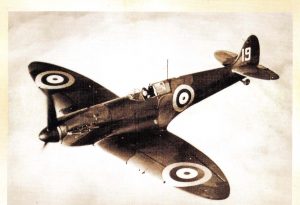 According to the Fighter Command Combat Report dated 5[September]1940, eleven members of the No. 19 Fighter Squadron, lead by Squadron Leader Pinkham, took off from RAF Duxford at 09:47 hours to patrol Hornchurch, an area of east London near the Thames Estuary. Forty Luftwaffe Dornier 215 bombers escorted by 40 Messerschmitt 109 fighters were spotted approaching from the west. At 10:15 hours, Tommy and five others attacked the bombers. The other five aircraft attacked the Luftwaffe fighters. Squadron Leader Pinkham was last seen engaging three Dornier 215 bombers and was a casualty.
Tommy’s Spitfire Mk1 crashed at Whitehorse Wood near Birling in Kent. A well maintained marker identifies the location of the crash.
According to the Fighter Command Combat Report dated 5[September]1940, eleven members of the No. 19 Fighter Squadron, lead by Squadron Leader Pinkham, took off from RAF Duxford at 09:47 hours to patrol Hornchurch, an area of east London near the Thames Estuary. Forty Luftwaffe Dornier 215 bombers escorted by 40 Messerschmitt 109 fighters were spotted approaching from the west. At 10:15 hours, Tommy and five others attacked the bombers. The other five aircraft attacked the Luftwaffe fighters. Squadron Leader Pinkham was last seen engaging three Dornier 215 bombers and was a casualty.
Tommy’s Spitfire Mk1 crashed at Whitehorse Wood near Birling in Kent. A well maintained marker identifies the location of the crash.
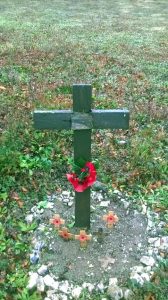 The following Tuesday, September 10th Tommy’s funeral was held at St. Andrew’s Church, the 12th century church where, 66 years later, I would come across his grave. As Tommy’s flag draped coffin was being brought in to the church, air raid sirens sounded. The bishop informed everyone that the church was not an approved air raid shelter and that those who wished to leave were free to do so. No one did.
The World War II Battle of Britain was the first major battle to be fought in the air and Tommy Pinkham was shot down at the height of it. It lasted 112 days, July 10th-October 31st, 1940. Hitler was determined to bomb England in to submission. Luftwaffe planes were continually bombing England and London was hit particularly hard. 40, 000 innocent civilians were killed. 1, 634 British planes were shot down. 2, 585 air crew members were killed. The Leon Paul Fencing Club in St. James, London was hit by an incendiary bomb. The Paul family lived above the Leon Paul manufacturing facility on Monmouth Street in London. When the hospital next door was bombed, collateral damage made the Paul’s home uninhabitable. The Paul’s moved to an upstairs flat in north London. During the day, while everyone was out, the flat was hit by a V1 bomb known colloquially as a “doodle bug.” Raymond Paul came home from school to find the place completely destroyed. British citizens were instructed to keep calm and carry on, because there really was no other choice.
On this Thanksgiving Day in 2016, seventy-six years after Tommy Pinkham lost his life in the Battle of Britain, I am thankful for the opportunity to have learned about this brave man and I am thankful for his ultimate sacrifice, so that others could live in freedom. I am also
thankful for the Paul Family. I am thankful for all they have done for the sport of fencing, all they have done for the employees of Leon Paul Fencing Equipment, but I am especially thankful for all they have done for me.
Happy Thanksgiving,
Bill Murphy, US Agent
Leon Paul USA
Atlanta, GA
The following Tuesday, September 10th Tommy’s funeral was held at St. Andrew’s Church, the 12th century church where, 66 years later, I would come across his grave. As Tommy’s flag draped coffin was being brought in to the church, air raid sirens sounded. The bishop informed everyone that the church was not an approved air raid shelter and that those who wished to leave were free to do so. No one did.
The World War II Battle of Britain was the first major battle to be fought in the air and Tommy Pinkham was shot down at the height of it. It lasted 112 days, July 10th-October 31st, 1940. Hitler was determined to bomb England in to submission. Luftwaffe planes were continually bombing England and London was hit particularly hard. 40, 000 innocent civilians were killed. 1, 634 British planes were shot down. 2, 585 air crew members were killed. The Leon Paul Fencing Club in St. James, London was hit by an incendiary bomb. The Paul family lived above the Leon Paul manufacturing facility on Monmouth Street in London. When the hospital next door was bombed, collateral damage made the Paul’s home uninhabitable. The Paul’s moved to an upstairs flat in north London. During the day, while everyone was out, the flat was hit by a V1 bomb known colloquially as a “doodle bug.” Raymond Paul came home from school to find the place completely destroyed. British citizens were instructed to keep calm and carry on, because there really was no other choice.
On this Thanksgiving Day in 2016, seventy-six years after Tommy Pinkham lost his life in the Battle of Britain, I am thankful for the opportunity to have learned about this brave man and I am thankful for his ultimate sacrifice, so that others could live in freedom. I am also
thankful for the Paul Family. I am thankful for all they have done for the sport of fencing, all they have done for the employees of Leon Paul Fencing Equipment, but I am especially thankful for all they have done for me.
Happy Thanksgiving,
Bill Murphy, US Agent
Leon Paul USA
Atlanta, GA
